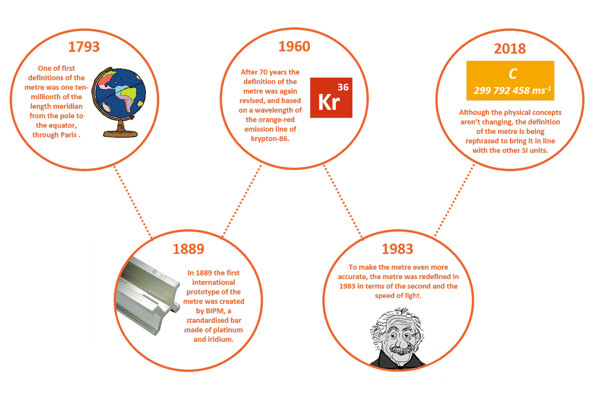Countdown to the SI redefinition

Throughout history, measurement has been a fundamental part of human advancement. The oldest systems of weights and measures discovered date back over 4000 years. Early systems were tied to physical objects, like hands, feet, stones and seeds, and were used, as we still do now, for agriculture, construction, and trade.
Yet, with new inventions and global trade more ever more accurate and unified systems were needed. In Europe, it wasn’t until the 19th Century that a universally agreed measurement system began to be adopted and the International System of Units (SI units) was born.
Now, after years of hard work and scientific progress, we are ready once again to update and improve the SI units. The redefinition of the International System of Units enacted on the 16 November 2018 during the General Conference for Weights and Measures will mean that the SI units will no longer be based on any physical objects, but instead derived through fundamental properties of nature. Creating a system centred on stable and universal natural laws will ensure the long-term stability and reliability of measurements, and act as a springboard for the future of science and innovation.
The redefinition of the SI units will come into force on the 20th of May 2019, the anniversary of the signing of the Metre Convention in 1875, an international treaty for the international cooperation in metrology. To celebrate, we’ll be counting down each of the SI units – the metre, second, kilogram, kelvin, mole, candela, and ampere. Join us on the 20th of every month to find out where units are commonly used, how they’re defined, and the changes that will take place!
UNIT OF THE MONTH: METRE
“You’ve never heard of the Millennium Falcon? … It’s the ship that made the Kessel run in less than 12 parsecs!” Han Solo’s description of the Millennium Falcon in Star Wars is impressive, but something’s not quite right. Do you know why? The unit he uses to illustrate the prowess of the Falcon – a parsec – isn’t actually a measure of time, but length! It probably won’t surprise anyone Han Solo isn’t very precise when it comes to the physics of his ship, but in fact he isn’t too far from the truth. This is because we use time to define length.
What does this mean? Well, in the case of Han Solo, one parsec is about 3.26 light-years, and a light-year is the distance light travels in one year. Back down on Earth, we have the same method for defining length. In the International System of Units (SI), the base unit of length is the metre, and it can be understood as:

A metre is the distance travelled by light in 1/299792458 of a second.
The reason we use the distance travelled by light in a certain amount of time is because light is the fastest thing in the universe (that we know of) and it always travels at exactly the same speed in a vacuum. This means that if you measure how far light has travelled in a vacuum in 1/299792458 of a second in France, Canada, Brazil or India, you will always get exactly the same answer no matter where you are!
On 20 May next year the official definition of the metre will change to:
The metre is defined by taking the fixed numerical value of the speed of light in vacuum c to be 299 792 458 when expressed in the unit m s−1, where the second is defined in terms of the caesium frequency, ∆ν.
We’ll be returning to the definition of the second on 20 March, so join us again then to find out more.
So, what’s the difference? Actually, there’s no big change coming for the metre. Although the word order has been rephrased, the physical concepts remain the same.
